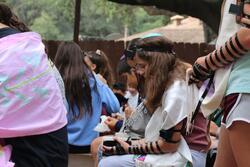My "Girl Power" Tefillin Journey: Wearing Davening Attire as a Girl
In countless Jewish spaces, kippot, tefillin, and tallit are explicitly gendered garments. My progressive egalitarian synagogue is no exception; yet, I grew up watching my rabbi—my mother—daven on the bema with her tallit wrapped around her shoulders and her kippah bobby-pinned to the top of her head. For a long time, wearing davening attire seemed like an active way of participating with G-d and draping myself in Their presence. It was the one thing in my life that was greater than any identifier or binary.
So, with this image of my mother in the back of my mind, I walked into Hebrew school on the first day with my bright pink kippah on and my head held high. It wasn’t until I noticed that I was the only girl wearing a kippah that insecurities started to surface. No one had said anything to provoke this self-doubt. Still, an inner dialogue began, chock-full of uncertainty and discomfort, loud enough that it drowned out the service. I had unknowingly challenged the status quo. And as we sang Adon Olam, all I could think about was this unintentional and unwanted revolution that I had caused by wearing a kippah. The next week, I walked into shul with my head uncovered, only to receive a disappointed glare from my mother.
These insecurities didn’t evaporate with age or experience. In fact, they got worse. Six years later, I arrived at my friend’s bat mitzvah with my newly gifted, handwoven tallit atop my shoulders. This tallit wasn’t just a piece of cloth; rather, it was a coat of armor that pushed me away from my friends on their phones and closer to G-d. I learned a few moments later, however, that this armor was not invincible; a flood of self-doubt and embarrassment quickly penetrated it. As I looked around, I realized with a sinking feeling that, once again, I was the only woman wearing this sacred garment. I was unable to focus on the Hebrew words in front of me, my thoughts now poisoned by shame and humiliation. I left the shul with a pit in my stomach and returned the next week without my tallit, vulnerable to what lay ahead.
Thankfully, these parallel events didn’t stop me from continuing my religious journey. My love for Jewish culture, religion, and spirituality grew, and I found myself continuously hungry for more knowledge. I knew that staying inside of my secular bubble wouldn’t suffice, so I packed up my things and left home to live in Israel for seven weeks.
When I left for Israel, that aforementioned secular bubble popped. My friends and I davened daily, each service suffused with love. During one of our frequent trips to the Old City, we stopped at the egalitarian Kotel to daven shacharit. I saw my friends pull their tefillin from their matte black bags and start to wrap them around their arms and heads. As our tour guide began to explain the history of the Kotel, I was finally able to comprehend the significance of where I was standing and what I was doing.
In front of me lay the remnants of the destruction of the second temple. Here was physical evidence of the hardships and persecution of the Jewish people. Overcome by a sense of sadness, joy, holiness, and connection to G-d, I realized that today would be the day where I wrapped tefillin for the first time. For generations, my ancestors were exiled, tortured, and slaughtered for openly expressing their Judaism. Here I was, generations later, with the opportunity to not only pray publicly but to etch my Jewish pride onto my skin and forehead with thick black leather.
I walked over to my friend and as she started to tightly wrap the tefillin around my arms and head, she explained the significance of each loop, each band, and of the box. For the first time in my life, I wasn’t looking around to find the other women who were participating in this holy deed. My inner monologue wasn’t full of insecurities and self-deprecation. For the first time, without the voice in my head, I was able to hear and participate in the spirited davening.
As our service ended, my friends and I decided to take photos in our tefillin to commemorate this moment. We huddled up and began cycling through the cliché “girl power” poses: flexed arm, hands on waist, etc. Eventually, a group of boys from our program walked up to my friends and me and started to point and laugh. “Hey! Can I take a photo? I’m going to take a photo. Smile for the camera!” The sarcasm in their voices was clear. To them, a girl wearing tefillin was humorous. My stomach dropped. Mortified, I immediately walked away from my friends. For the rest of the day, as we continued to tour the Old City, all I could think about was the snide look on the boys’ faces as they laughed.
I often daydream about alternate realities, and this moment is no exception to that. In the new and improved version of the story in my head, the boys still make their snarky comments and laugh. But instead of escaping with my head hung low, I fix my posture, take a deep breath, and walk away from the boys with composure and a disappointed glare spread across my face. Sadly, I didn’t actually do that. And honestly, I think if I were given another chance now, I would repeat my mistakes. I’m still on a journey to find inner strength and confidence. Thankfully, one of the beauties of Judaism is its emphasis on individuals’ ability to evolve and grow. One day, I hope to walk into an egalitarian Jewish space with my tallit on my shoulders and my kippah on my head, unbothered by my gender’s relationship to these objects—only focused on and moved by prayer, community and ritual.
This piece was written as part of JWA’s Rising Voices Fellowship.








As long as a woman accomplishes all the mitzvos she has to, there is no problem if the adds mitzvos she doesn't have to.
But better learn how they should be done. Learn how to put on tefilin properly ❗